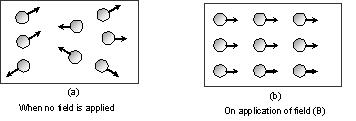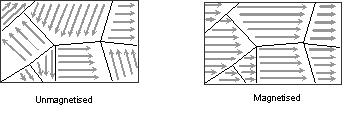Magnetic Materials
Types of magnetic materials
On the basis of mutual interactions or behavior of various materials in an external magnetic field, the materials are divided in three main categories.
(i) Diamagnetic materials: Diamagnetism is the intrinsic property of every material and it is generated due to mutual interaction between the applied magnetic field and orbital motion of electrons.
(ii) Paramagnetic materials: In these substances the inner orbits of atoms are incomplete. The electron spins are uncoupled, consequently on applying a magnetic field the magnetic moment generated due to spin motion align in the direction of magnetic field and induces magnetic moment in its direction due to which the material gets feebly magnetized. In these materials the electron number is odd.

(iii) Ferromagnetic materials: In some materials, the permanent atomic magnetic moments have strong tendency to align themselves even without any external field.
These materials are called ferromagnetic materials.
In every unmagnetised ferromagnetic material, the atoms form domains inside the material. The atoms in any domain have magnetic moments in the same direction giving a net large magnetic moment to the domain. Different domains, however, have different directions of magnetic moment and hence the materials remain unmagnetised. On applying an external magnetic field, these domains rotate and align in the direction of magnetic field.

COMPARATIVE STUDY OF MAGNETIC MATERIALS
Property
|
Diamagnetic substances
|
Paramagnetic substances
|
Ferromagnetic substances
|
Cause of magnetism
|
Orbital motion of electrons
|
Spin motion of electrons
|
Formation of domains
|
Explanation of magnetism
|
On the basis of orbital motion of electrons
|
On the basis of spin and orbital motion of electrons
|
On the basis of domains formed
|
Behaviour In a non-uniform magnetic field
|
These are repelled in an external magnetic field i.e. have a tendency to move from high to low field region.
|
These are feebly attracted in an external magnetic field i.e., have a tendency to move from low to high field region
|
These are strongly attracted in an external magnetic field i.e. they easily move from low to high field region
|
State of magnetisation
|
These are weekly magnetised in a direction opposite to that of applied magnetic field
|
These get weekly magnetised in the direction of applied magnetic field
|
These get strongly magnetised in the direction of applied magnetic field
|
When the material in the form of liquid is filled in the U-tube and placed between pole pieces.
|
Liquid level in that limb gets depressed
 |
Liquid level in that limb rises up
 |
Liquid level in that limb rises up very much
 |
On placing the gaseous materials between pole pieces
|
The gas expands at right angles to the magnetic field.
|
The gas expands in the direction of magnetic field.
|
The gas rapidly expands in the direction of magnetic field
|
The value of magnetic induction B
|
B < B0
|
B > B0
|
B >> B0
|
Magnetic susceptibility χ
|
Low and negative |χ| ≈ 1
|
Low but positive χ ≈ 1
|
Positive and high χ ≈ 102
|
Dependence of χ on temperature
|
Does not depend on temperature (except Bi at low temperature)
|
Inversely proportional to temperature χ ∝ 1/T or χ= C/T.This is called Curie law, where C = Curie constant
|
χ ∝ 1/T-Tc or χ = C/T-Tc.This is called Curie Weiss law.
Tc = Curie temperature
|
Dependence of χ on H
|
Does not depend independent
|
Does not depend independent
|
Does not depend independent
|
Relative
permeability (μr)
|
μr < 1
|
μr > 1
|
μr >> 1
μr = 102
|
Intensity of magnetisation (I)
|
I is in a direction opposite to that of H and its value is very low
|
I is in the direction of H but value is low
|
I is in the direction of H and value is very high.
|
I-H curves
|  |  |  |
Magnetic moment (M)
|
The value of M is very low (χ 0 and is in a direction opposite to H.)
|
The value of M is very low and is in the direction of H
|
The value of M is very high and is in the direction of H
|
Transition of materials (at Curie temperature)
|
These do not change.
 |
On cooling, these get converted to ferromagnetic materials at Curie temperature
 |
These get converted into paramagnetic materials above Curie temperature
 |
The property of magnetism
|
Diamagnetism is found in those materials the atoms of which have even number electrons
|
Paramagnetism is found in those materials the atoms of which have majority of electron spins in the same direction
|
Ferro-magnetism is found in those materials which when placed in an external magnetic field are strongly magnetised
|
Examples
|
Cu, Ag, Au, Zn, Bi, Sb, NaCl, H2O air and diamond etc.
|
Al, Mn, Pt, Na, CuCl2, O2and crown glass
|
Fe, Co, Ni, Cd, Fe3O4 etc.
|
Nature of effect
|
Distortion effect
|
Orientation effect
|
Hysteresis effect
|
where B0 is the magnetic induction in vacuum
